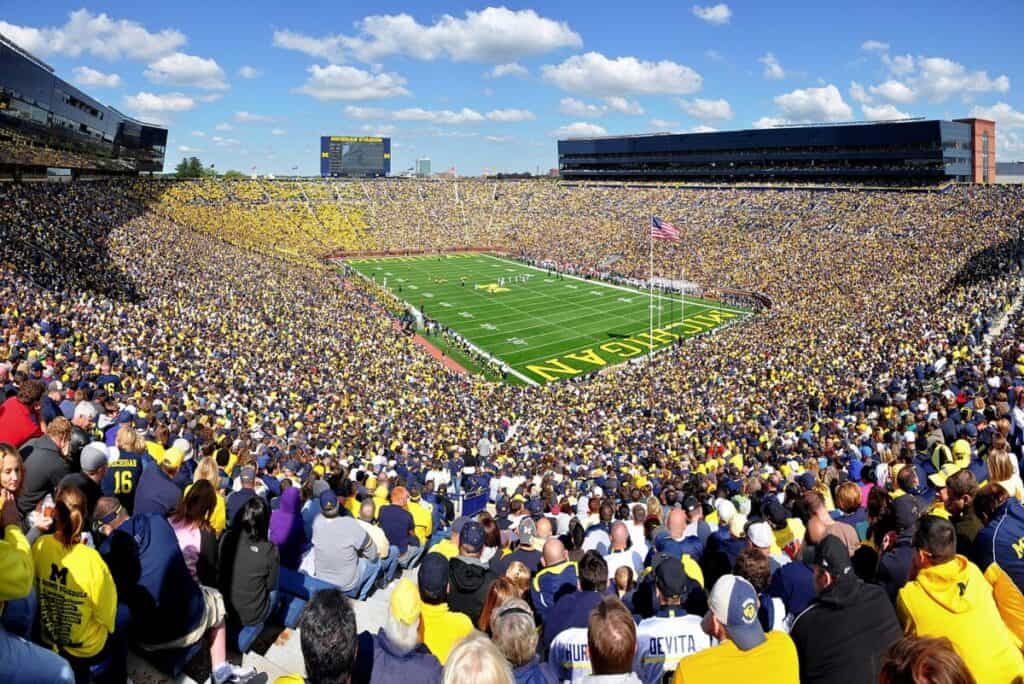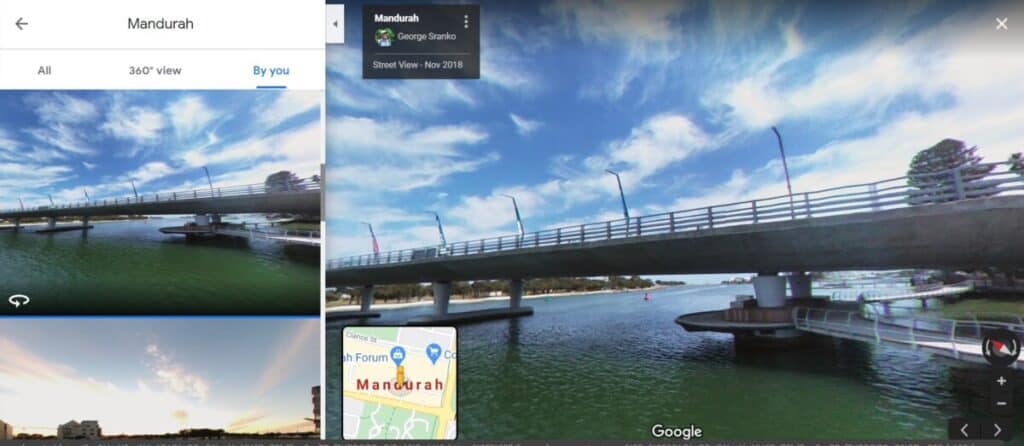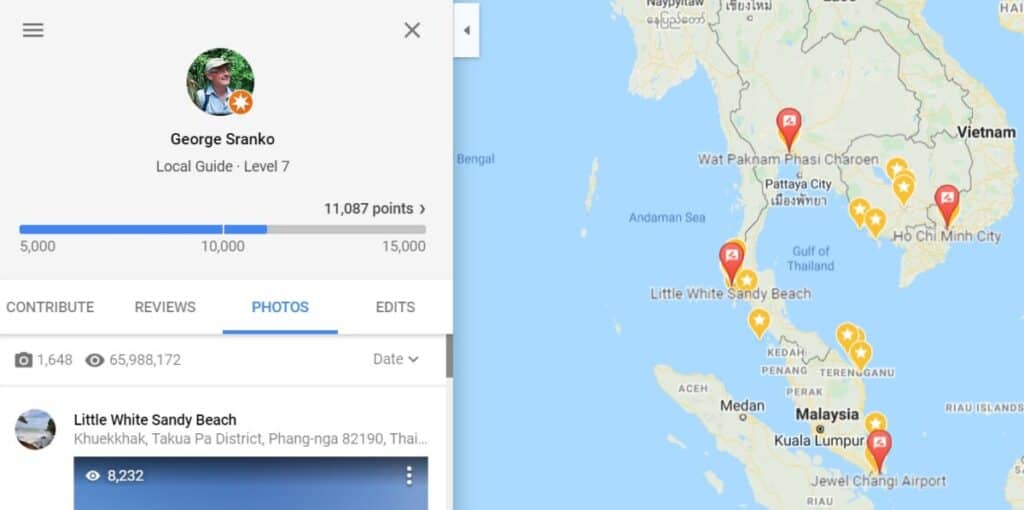My portfolio of online photos attracts over one million views per month. At the time of writing, I’ve received over 80 million views in total.
My favorite platform for attracting millions of viewers to my online photos is Google Maps. I have several photos with over one million views each, and one photo with roughly 5 million views. In this article I will show you little-known secrets to attracting millions of viewers to your photos and how to leverage non-revenue views into meaningful traffic to your monetized website.
Photos and videos on Google Maps (GM) don’t earn any income. However, they can give your brand high exposure and potentially a source of traffic.
I can’t imagine what a million people would look like. The largest stadiums in the world have a capacity of roughly 100,000 people. Using my approach, you could fill Michigan stadium with your viewers over ten times per month or every 3 days! These numbers just boggle my mind!

Make your photos unique
I’ve noticed that lots of folks submit photos of their lunch or dinner, taken while sitting at a favorite restaurant. Nothing wrong with that. In fact, Google Maps likes having the connection you’ve established with a commercial enterprise. After all, Google is in the business of selling ads.
To be brutally honest, the likelihood of your lunch attracting millions of views is slim. There must be thousands and thousands of photos of other people’s lunches competing with yours.
My favorite trick to attracting large numbers of viewers is to submit 360 photos. This is not essential, but has proven to be very effective in boosting my numbers. Of my photos with over 1 million views, only one of them is a non-360 photo taken in the Cook Islands. Even so, many of my standard non-360 photos still get hundreds of thousands of views.

The fun of taking 360 photos
I began taking 360 photos with my android cell phone back in 2015. It all began with a Google camera app that I downloaded out of curiosity. I was playing around with it when I noticed that it had a setting for 360. I didn’t know what to expect but followed the instructions – and voila! I had a very cool 360 image on my phone.
Taking a 360 photo with my cell phone was not a graceful procedure. It would take me at least a minute for each 360 photo, spinning on the spot and covering an imaginary sphere all around me with overlapping shots. Undergo these contortions in the middle of Times Square if you want to attract some attention! (speaking from personal experience)
The beauty of the camera app is that it stitches the individual shots together into one finished 360 photo – or photosphere – right on the spot. This takes some impressive computing power, when you think about it and the phone technology probably wasn’t available until 2014 or so. Once the photo is stitched together, you can spin it in all directions as if you were standing inside the sphere.
I’ve titled one of my favorite early 360s “The Hand of God.” I was with a small group of friends, when I began doing my 360-dance covering an imaginary sphere with my cell phone. At one point I was shooting directly into the sun and shaded the phone with my hand. Once the photosphere was complete I took it for a spin… and broke out laughing out loud. There was my disembodied hand poised among the clouds… looking like the hand of God!

Google Maps appreciates 360 photos
I’m not certain how Google Maps prioritizes the millions of photos posted on their platform every day, but I know from experience that 360 photos are given a bit more prominence. When you look at any location on GM and click on the photos to the left, you’ll see that 360 photos are organized under a separate column.

You can immediately boost your profile by posting 360 photos. If you click on a GM photo, you’ll see the name or identity of the photographer.

Click on the name and you’ll be taken to the photographer’s GM portfolio, showing the number of photos posted and the total number of views. You can sort the photos by date and by number of views, although the individual photos won’t show you the number of views. As far as I can tell, only the photographer can see the number of views for each individual photo.

Each photo location is shown on the map, and if you hover over the red location pin a tiny thumbnail will pop up. This is how you can find one of your own photos. Go to a specific location and click on the photos. You should see a column heading “By you.” This is a handy trick to finding a specific photo, once you have hundreds of photos spread all over the planet!

Further tips for getting more views
If you post a 360 photo of your back yard, your family might be interested, and you might get a few curious viewers stumbling upon it. But what is the likelihood of millions of views? Pretty darn slim.
So how do you post photos that people will be searching for? Here are some ideas to set your photos apart:
- First, you need to take photos in interesting locations. There are interesting locations all around you, including parks, beaches, historic sites, famous buildings…you name it.
- Travel with a 360 camera. Photospheres taken in iconic or exotic locations will always attract an interested audience. I’ll show you my top 3 photospheres in terms of views at the end of this article.
- Choose your spot carefully. Since a 360 photo is a very wide angle shot, distant objects appear small and insignificant. I always try to stand close to at least one object (or person) to make it more prominent in the final photosphere. A totally flat scene without anything of interest in the foreground will end up boring everyone, including your mother.
- Post to Cities, States, and Countries in addition to smaller, more specific locales. You can post the same photo to several locations on Google Maps. Some of my photos with the greatest number of views are posted to higher level postings, including cities and countries. I have photos listed under a particular park, for example, with a few hundred views. Meanwhile, the same photo listed under the name of the city can get hundreds of thousands of views.
Camera technology has come a long way
I haven’t used my cell phone for 360s for at least three years. I’m on my second 360 camera and about to spring for my third. The latest and greatest at the current time, in my estimation, is the Insta360 One R. It is like a waterproof 360 version of a GoPro. I’ve been using an Insta360 One X for over a year and love the fact that I can take a photosphere in one click. My 360 dancing days are long gone! Not only that, but the latest cameras record videos in full 360 as well – 3D videos.
YouTube is 3D-friendly
This means that you can post 360 or 3D videos onto YouTube and viewers can spin the image around as it plays. This is an awesome experience! The viewer can choose the direction of focus and look all around as the scene changes.
One more exciting feature is the ability to make 2D videos from the original 360 footage, allowing you to choose your point of view in post-production as the video progresses. These 2D versions can then be posted as regular YouTube videos.
What good are millions of views on Google Maps?
At the time of writing, there’s no direct revenue from photos posted on GM. However, here’s nifty secret. When you label your photos on GM, you might want to add your domain name. Here’s an example of one of my top photos taken in Cape Town, South Africa, showing my domain name BioGeoPlanet.com. Some photographers post in the name of their company or using a unique username, which could easily include a domain name.

Say you get 1% of viewers intrigued enough to come check out your website. 1% of 1 million = 10,000. One million views of your GM photos could generate thousands of visitors to your website every month.
OOPS! Reality Check!
NOTE: I’ve since discovered that THIS DOES NOT WORK! When I first wrote this post, I thought I would be receiving tons of traffic from Google Maps, since I was getting millions of views of my photos.
NOT SO. Very few of the visitors to this website BioGeoPlanet.com come by way of Google Maps. The vast majority of my traffic comes from organic Google search results.
Examples showing my top 3 photospheres
Here are my top 3 photospheres on Google Maps, by the number of views at the time of writing. You can view the photos and take them for a “spin” in real life by going to my accompanying post:
Houses of Parliament, Cape Town, South Africa – 4.6 million views
Auckland Domain Wintergardens, Auckland, NZ – 4.1 million views
Cottesloe beach at sunset, Perth, WA, Australia – 2.8 million views
You can take these photos for a spin
I’ve embedded these three photospheres in my accompanying post. Please take a look and spin around inside for the 360 view.
Click here to see my entire portfolio of over 1,500 photos posted to Google Maps, the majority of them as 360s or photospheres.
Our Favorite Gear for Research Expeditions
We love to travel in search of exceptional wildlife viewing opportunities and for life-enhancing cultural experiences.
Here is the gear we love to travel with for recording our adventures in safety and comfort:
- Action Camera: GoPro Hero10 Black – we find these waterproof cameras are invaluable for capturing the essence of our adventures in video format. Still photos are great, but video sequences with all the sights and sounds add an extra dimension. I use short video clips to spice up many of my audiovisual presentations.
- Long Zoom Camera: Panasonic LUMIX FZ300 Long Zoom Digital Camera – I love this camera for its versatility. It goes from wide angle to 28X optical in a relatively compact design. While on safari in Africa I’ve managed to get good shots of lions that the folks with long lenses kept missing – because the lions were too close! I also like the 120 fps slow-motion for action shots of birds flying and animals on the move. I call this my “bird camera.”
- 360 Camera: Insta360 ONE R 360 – 5.7K 360 Degree Camera, Stabilization, Waterproof – see my article How to Take Impossible Shots with Your 360 Camera. This camera is literally like taking your own camera crew with you when you travel! Read my article and you’ll see why.
- Backpack camera mount: Peak Design Capture Clip
- Drone: DJI Mini 2 (Fly More Combo) – this mini drone is made for travel!
- Water Filtration: LifeStraw Go Water Filter Bottle
- Binoculars: Vortex Binoculars or Vortex Optics Diamondback HD Binoculars (good quality at a good price)
See Our TOP Articles for Even More Fascinating Creatures
- Are Birds Dinosaurs? Latest Science (How Birds Evolved from Dinosaurs)
- How do Snakes Mate? (Snake Reproduction Explained in Detail – with Videos and Diagrams)
- How do Octopus Reproduce? (Cannibalistic Sex, Detachable Penis)
- How Smart are Octopuses? Are Octopuses As Intelligent as Dogs?
- How do Electric Eels Shock Their Prey? Can an Electric Eel Kill You?
- Do Jellyfish have Brains? How Can they Hunt without Brains?
- Why are Deep Sea Fish So Weird and Ugly? Warning: Scary Pictures!
- Are Komodo Dragons Dangerous? Where Can you See Them?
- Koala Brains – Why Being Dumb Can Be Smart (Natural Selection)
- Why do Lions Have Manes? (Do Dark Manes Mean More Sex?)
- How Do Lions Communicate? (Why Do Lions Roar?)
- How Dangerous are Stonefish? Can You Die if You Step on One?
- What Do Animals Do When They Hibernate? How do they Survive?
- Leaf Cutter Ants – Surprising Facts and Adaptations; Pictures and Videos
- Irukandji Jellyfish Facts and Adaptations; Can They Kill You? Are they spreading?
- How to See MORE Wildlife in the Amazon: 10 Practical Tips
- Is it Safe to go on Safari with Africa’s Top Predators and Most Dangerous Animals?
- What to Do if You Encounter a Bullet Ant? World’s Most Painful Stinging Insect!
- How Do Anglerfish Mate? Endless Sex or Die Trying!
- How Smart are Crocodiles? Can They Cooperate, Communicate…Use Tools?
- How Can We Save Our Oceans? With Marine Sanctuaries!
- Why Are Male Birds More Colorful? Ins and Outs of Sexual Selection Made Easy!
- Why is the Cassowary the Most Dangerous Bird in the World? 10 Facts
- How Do African Elephants Create Their Own Habitat?
- What is Killing Our Resident Orcas? Endangered Killer Whales
- Why are Animals of the Galapagos Islands Unique?
- Where Can You See Wild Lemurs in Madagascar? One of the Best Places
- Where Can You see Lyrebirds in the Wild? the Blue Mountains, Australia
- Keeping Mason Bees as Pets
- Why do Flamingos have Bent Beaks and Feed Upside Down?
- Why are Hippos Dangerous? (Do They Attack People?)
